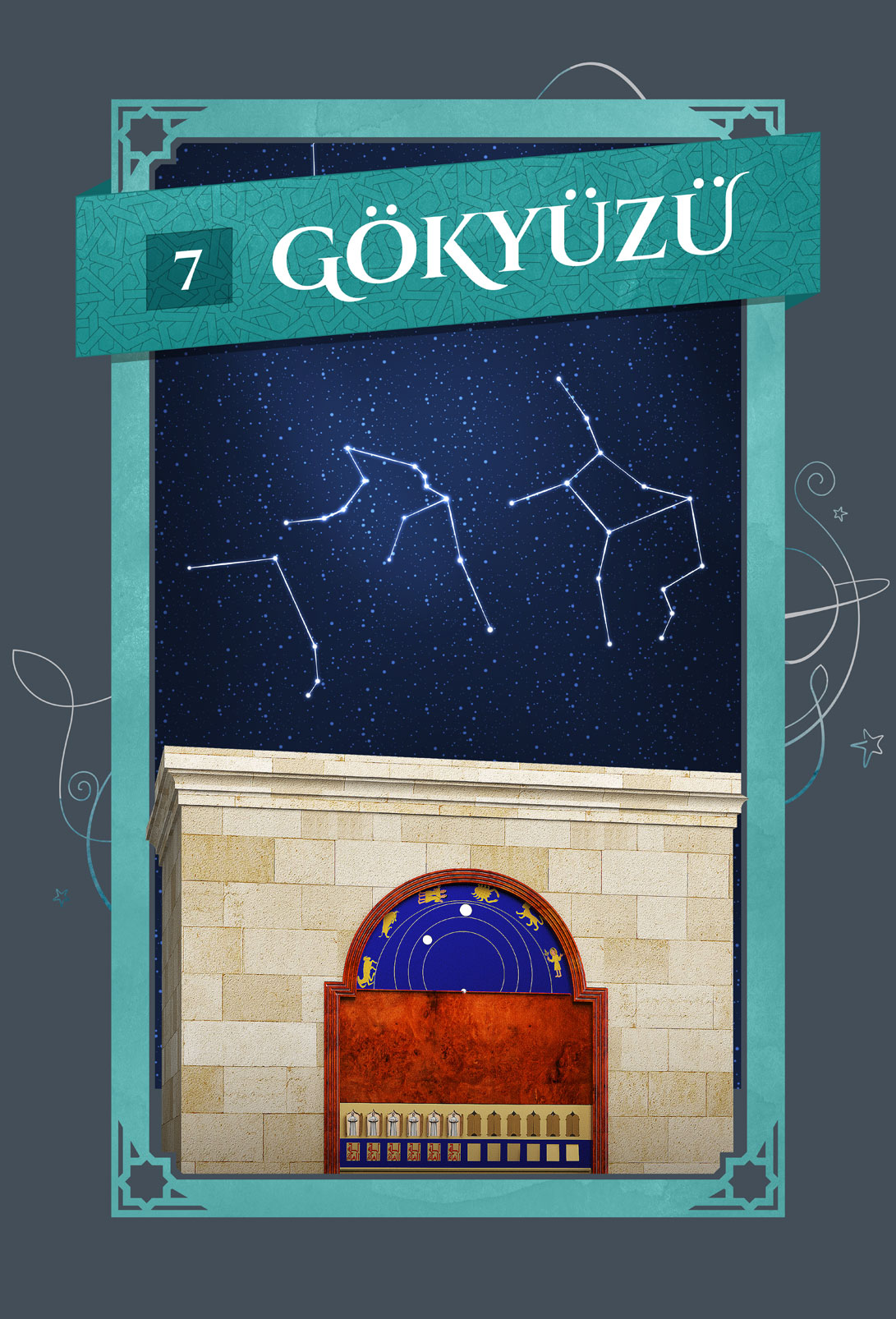Our beautiful and great clock up in the sky.
Time is up in the sky for the mankind. Sun, stars, planets rotate and move, hours, days, years pass, and our heavenly clock keep working. When we look up at the sky, we can see our clock – and our days, months, and years as well. Well, can a water clock tell us the position of sun in the sky? Or moon? Stars? Sun set, or will rise soon… or it’s right at its zenith… Can it? While Jazari’s mechanical water clocks worked on the equal time system, they could follow the solar time, too. With is vast knowledge on astronomy, Jazari adjusted the water flow according to the each day of any year in a way that it followed the sun’s position up in the sky, and inform us about the positions of the moon and stars as well.
Monumental Water Clock Reconstructed
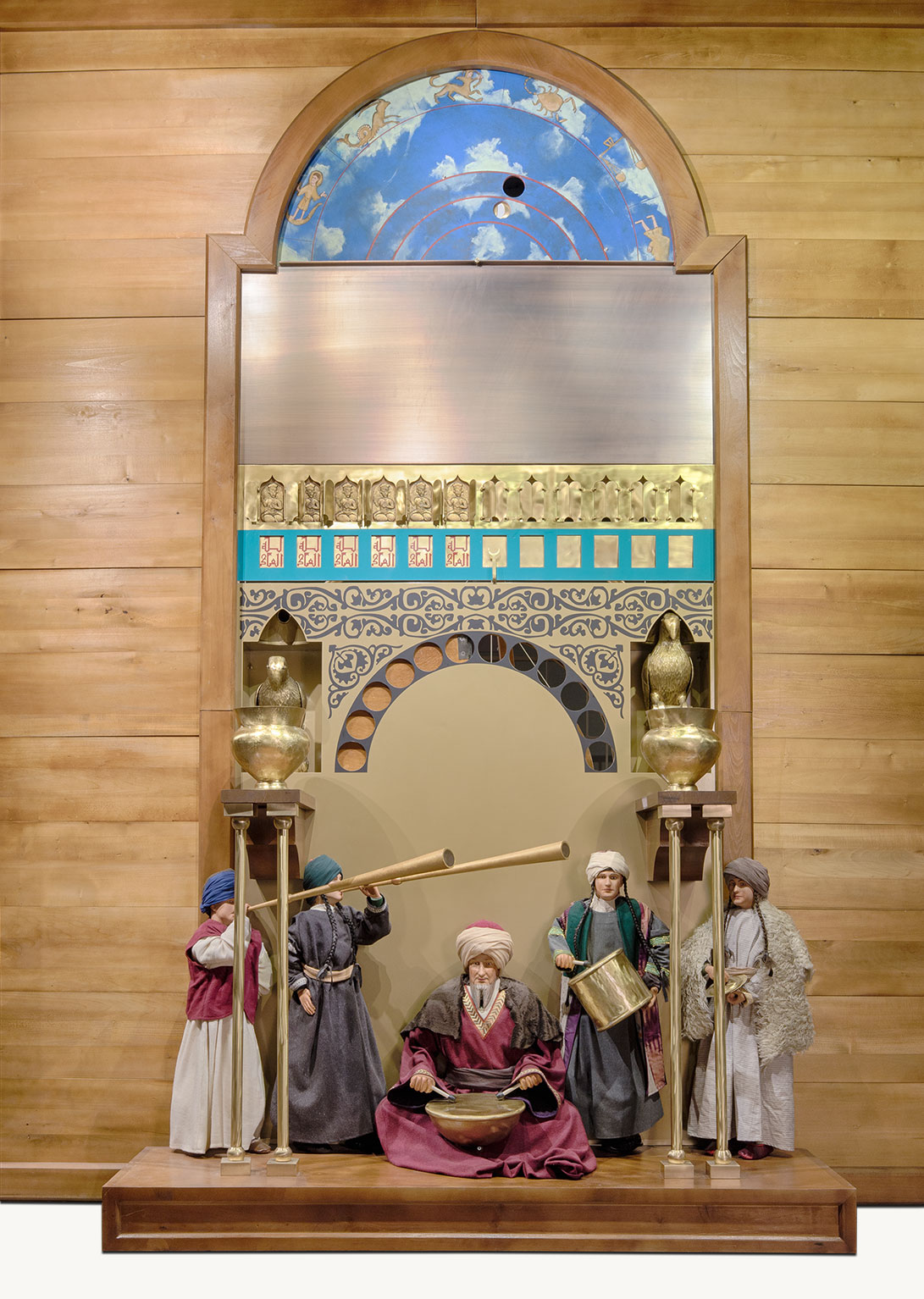

This clock of Jazari is the most advanced among all of his devices. While it’s a monumental clock with its height of almost 4 meter, it also contains highly advanced techniques with its feature of following the solar time. This is the first clock in the history that can follow sun’s changing movements with a varying dial speed. The dimensions of the clock at its base is 3.2 m x 2.8 m, and it’s 3.8 m tall. It’s based on the Solar Time System that takes both the day and night as 12 parts, which imported to Islamic world from Hellenistic period. According to this system, differently than Equal Time System we use today, the span of 1 hour time varies from day to day. Therefore, this clock has a very complicated design. It’s powered by water emptied from a chamber at a controlled speed. At the turn of every hour, a window opens, a human figurine appears, and a short quote of word comes out in the windows below it. Small circular windows lined in a crescent shape at the middle lighten up, and bronze balls come out of the hawks, making a gong sound. In the meantime, the musician figurines at the bottom play drums, cymbals, and trumpets at specific times, informing people for the prayer times. Also, at the top of the clock, the daily positions of the heavenly bodies are shown. Clock is reset with the refill of water at the turn of day and night, in addition to some other adjustments. While he drew some from other engineers before his time, Jazari invented lots of methods and systems for this clock. The most important ones are the stopper float he used to control the water flow, and the regulator that adjusts the flow based on the length of the any given day.
How Does It Work?
This clock is powered by a water engine. Timing is done with the water inside this cylindrical chamber, and decrease of the water here also provides the energy. It decreases slowly, and arms of the clock are rotated by the movements of this decrease that is connected to pulley systems. These pulleys control the astronomy dial (4), and the movement of the second pulley is transferred to the circular dial’s pulley below. On the other hand, the pulley system draws the cart that carries very important functions. As the cart moves from rightmost end to the other for 12 solar hours, it triggers the systems that open the doors and windows. Moreover, at the turn of every hour, the ball raises the blades inside its chamber, and releases two balls. These balls roll into the box of hawk mechanism, rolling them over, and fall into the vases from the beaks. There is a stopper float in front of the water engine to control the water flow. Water comes out of this tank, and goes through a regulator that Jazari called as destur. Regulator adjusts the water flow based on the length of the day or night, and empties the chamber within the exact time between the sunrise and sunset in any given day. It’s some sort of an analog computer. Water piles up in the trays and goes to the scooped gear for three times a day, rotating the shaft that controls the percussionists’ robotic arms, and then continues to the pressure chamber to create a whistle sound.
Transparent Flow Regulator

The last element of the water engine is the flow regulator that controls the flow of water based on the length of every day and every night. This device that Jazari called as “destur” is a pioneer of the mechanical regulators. As the stopper float fixes the water level, this regulator is moved to the right angle every day so that it changes the height of exit hole, adjusting the flow. Thus, the timing follows the lengthening and shortening of the days and nights throughout the year. When the system is reset at the sunrise, the float is at the middle when the sun is at its zenith, and at the bottom at sunset.
Jazari developed this regulator to follow the length of days along the year, using the principle of changing pressure level based on the surface level of liquids that pressurize the surfaces of the cup they’re in due to their weight. The reason of this is the liquidity and formlessness. The pressure is based on the depth and the density of the liquid. If there are holes along the surface of a cylindrical cup that holds water, the water flow through these holes decrease as from bottom to the top. Water flows fastest at the deepest point.
As you can see here, there are two cylindrical cups. The water inside the larger cup flows into the second cylinder through a hole. To keep the amount of water at the same level, Jazari used a stopper. And now we will explain how he adjusted the flow depending on the length of days that change throughout the year. For this purpose, there is a mechanism connected to a hole at the bottom of the second cylinder. On this mechanism, which is called “destur,” there is a dial that shows all the months of a year, and a handle rising to the edge from behind. With the help of this handle, water comes out through the hole at differing heights so that the flow can be fixed.
Percussionist Mechanism
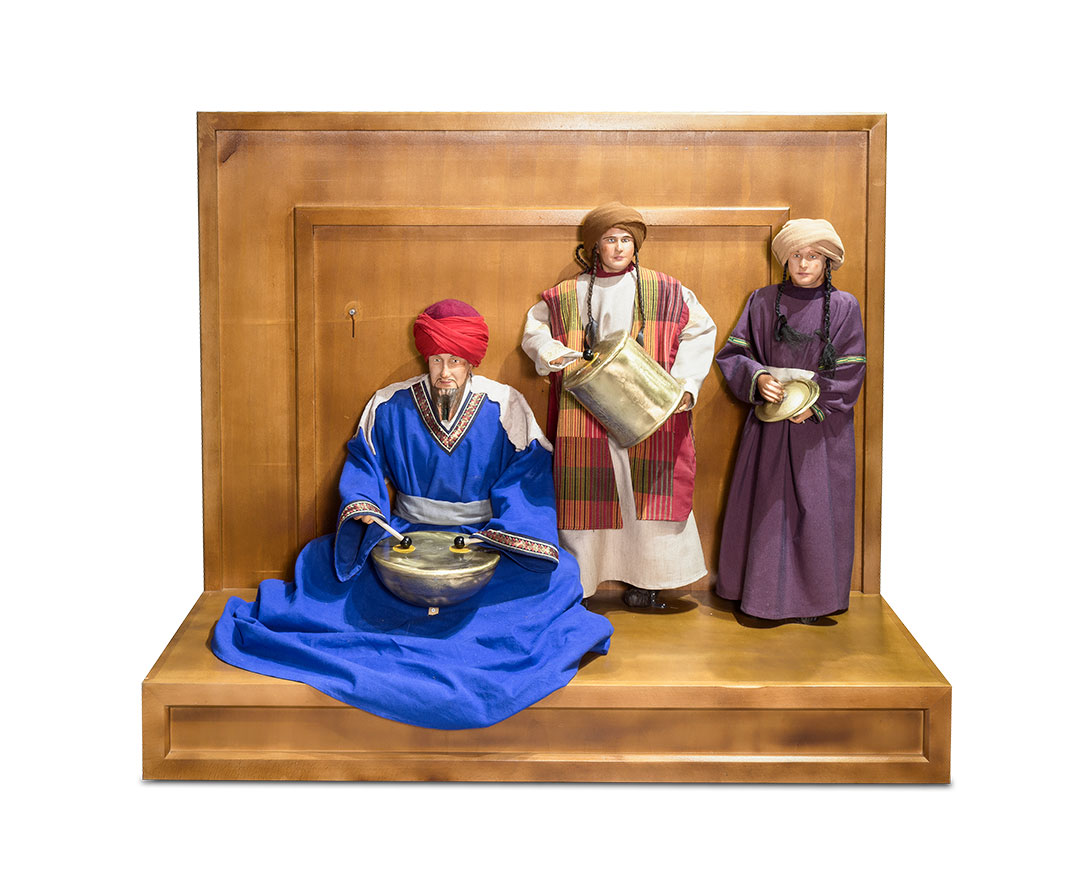
The most impressive part of the clock is the show of percussionists. The robotic system is adjusted in a way that they work 3 times for every day and 3 times for every night. At 6, 9, and 12, percussionists remind the watchers for the time of change. They also notify the time of prayers. This system is similar to the drums of a piano automat. 4 arms of the 3 musicians are robotic, and there are four pedals for these arms. Distributing the nails along the shaft at desired numbers and positions, we can provide a rhythm at every rotation. One arm of the sitting drummer hits twice, and the other once. One arm of the standing drummer hits twice, and cymbalist’s thrice. Distributing the nails at desired angles, sounds can be produced together or one after another.
Astronomy History Poster
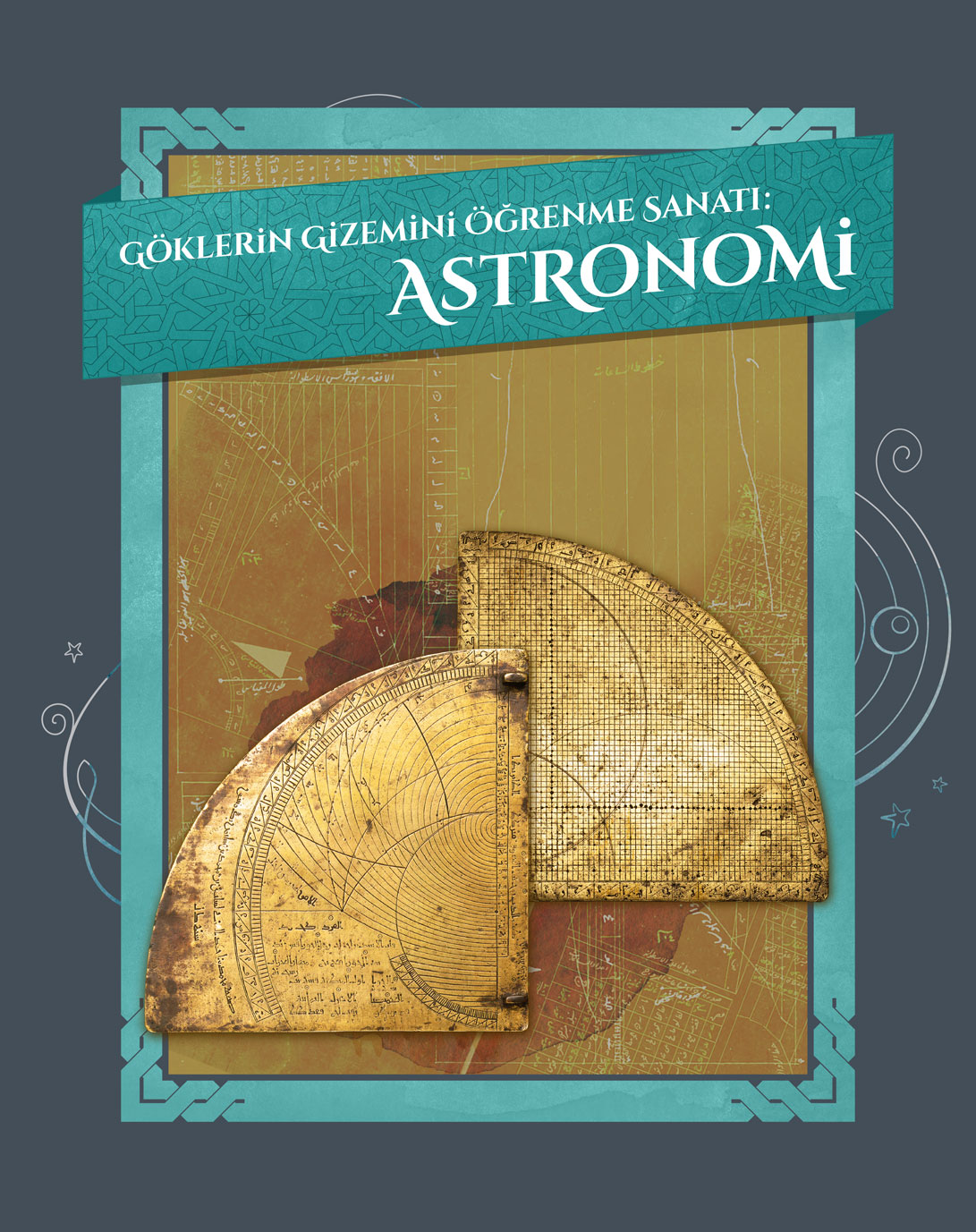
The Art of Learning the Heavenly Mystery – Astronomy
It’s hard to see any other scientific discipline that is as mysterious, which encourages people because of the curiosity it creates. The efforts to understand the universe that is full of countless unknowns are as old as the history of mankind. However, the attempt to raise this interest up to the level of scientific knowledge started in Mesopotamia around five thousand years ago. With the development of mathematics that has been used in observations and processing the findings, from the length of a year to determining the orbits of planets, experimental knowledge began to transform into calculable knowledge. Rising from Babylon, astronomy fed on the geometrical universal models in ancient Greek philosophy in 4th Century B.C., and then kept developing through Indian, Persian, and Chinese cultures.
Evrendeki düzeni anlama çabası, Müslümanlar için bir meraktan öte, ilahi gücün temsilini açığa çıkaran önemli bir işarettir. Dahası, göklerdeki düzenliliğin, yeryüzündeki hayata dair ipuçları verdiği de düşünülmüştür. Bu düzeni anlamanın yolu öncelikle gözlem yapmaktan, iyi gözlem yapabilmenin yolu da hassas aletler kullanmaktan geçer. Gözlemlerde elde edilen veriler de doğru formüller ve hesaplar yardımıyla çözümlenir. Bu bakımdan astronominin gelişimi, bugün olduğu gibi hem alet yapım tekniklerine hem de matematiksel bilimlere bağlı olmuştur.
In 8th Century, expanding to a vast geography, Islam civilization took from the cultural and scientific legacy of the lands it reached. While the Indian, Persian, and Greek knowledge was translated to Arabic, both a new scientific language was born, and the data from various sources were able to be synthesized.
The effort to understand the universal order was a great symbol for the divine power for Muslims, far beyond curiosity. Moreover, it was thought that the order up in the skies hinted to the one in the world. So, mankind had to observe to understand this order, and to do that, sensitive devices were required. And all the data acquired through these observations are solved by the right formulas and calculations. Therefore, astronomy improved based on the invention of these devices and mathematics.
After 9th Century, astronomers rose from almost every corner of Islamic world, observatories were built, and countless books were penned. Al-Birunī, al-Tusī, Ibn al-Satr, Ali Kuscu, and many others became the milestones of the road that led to modern science. Systematical observations held in the observatories built in Maraga, Samarkand, and Istanbul were the institutes, using humongous devices, leading the path to the idea of modern institutes.
Observation activities weren’t only limited to the observatories, but astrolabe, rub’u’l-mukhantarāth, and water clocks were made to measure the time, to notify for the prayer times, finding the kıblah direction, and calculate the beginning of Ramadan, which all helped to solve daily needs of Islamic way of life. Within the Islamic culture, countless observation and calculation devices were designed to reach more viable conclusions. Among them, the water clocks designed by Jazari, who was the top expert on astronomy in his own time, 12th Century, were highly important due to their ability to follow the changes of heavenly bodies throughout the year.
Astronomical Dial
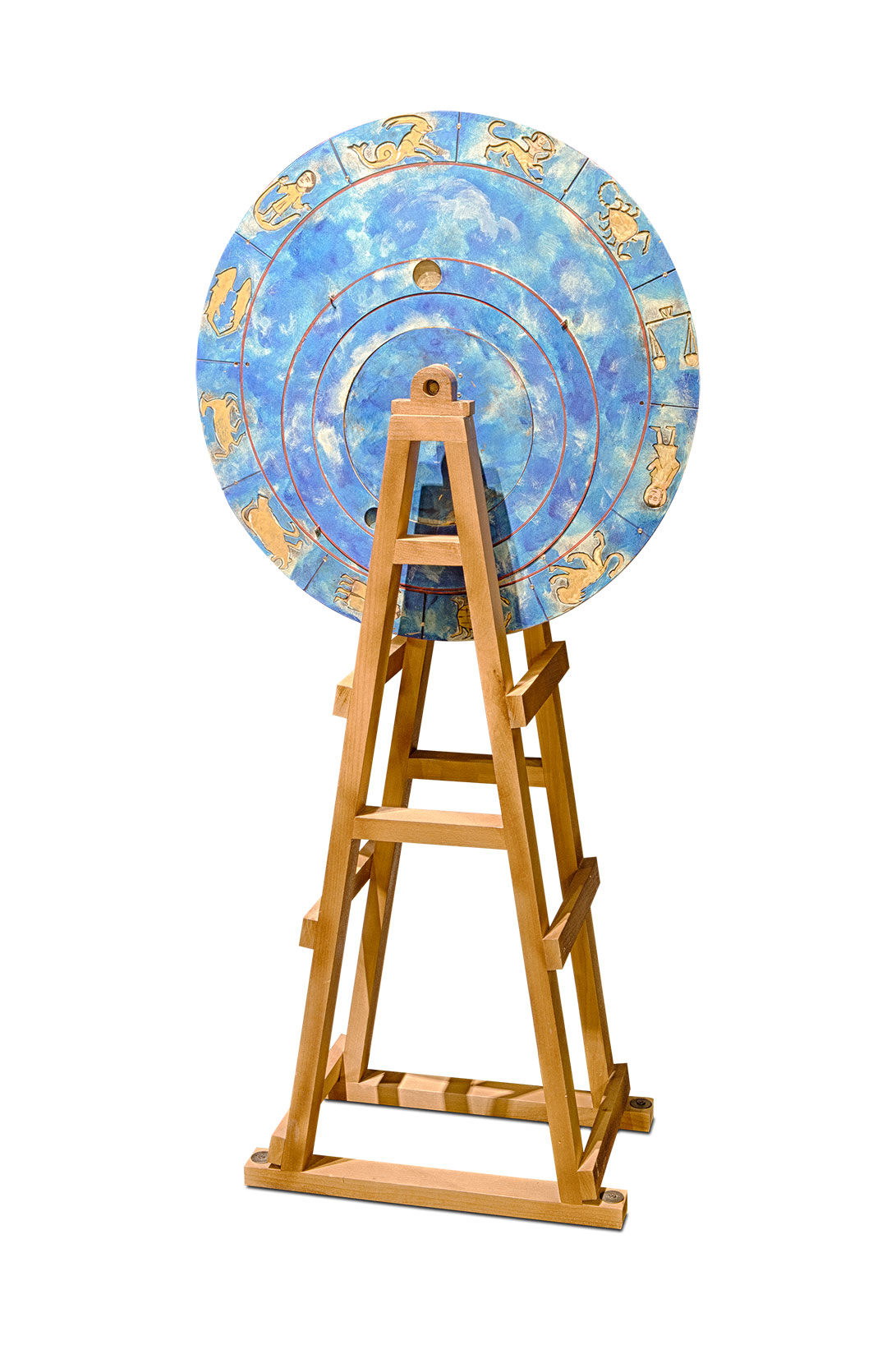
Doubtlessly, one of the most important parts of the Monumental Water Clock is its astronomical dial, which gained the clock another name, “Astronomical Clock.” On the dial, the orbits of sun and moon are represented with adjustable rings. They are placed on the horoscope signs they belong at the turn of every day. On the other hand, main sign ring is moved to the right angle for the day. When the clock begins to run, depending on the day of a year in question, corresponding sign rises and the one 6 steps ahead begins to set. For 12 sun hours, dial rotates for 180 degrees, and shows the positions of sun, moon, and signs up in the heavens. We should remember that these signs are the Zodiac constellations that remain behind the world as it moves around the sun. Therefore, at the sunrise, we see the constellations behind the sun. Since we can relate the positions of constellations to the lengths of days, the signs are also a calendar system.
Feedback in Mechanics Poster
Feedback system can be explained simply with this diagram.
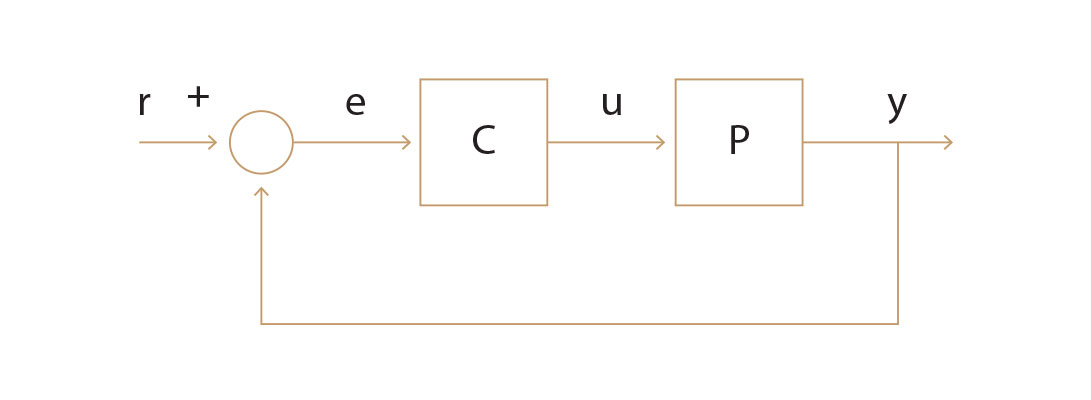
Here in this image…
• P can be thought as system that runs without a clear specification. It symbolizes a mechanism or an organism.
• C is an additional system that controls the first one.
• y is the result value that can be measured. This value can be measured sometimes by a sensor or a mechanical structure.
• r is a reference value. It’s the value asked or given by the system in the beginning.
• e is the value of error. The error value that comes from the feedback channel symbolizes the difference between the reference value and the result value, and it shows how far we are from the reference value.
• u is the control command, which is needed to run the system.
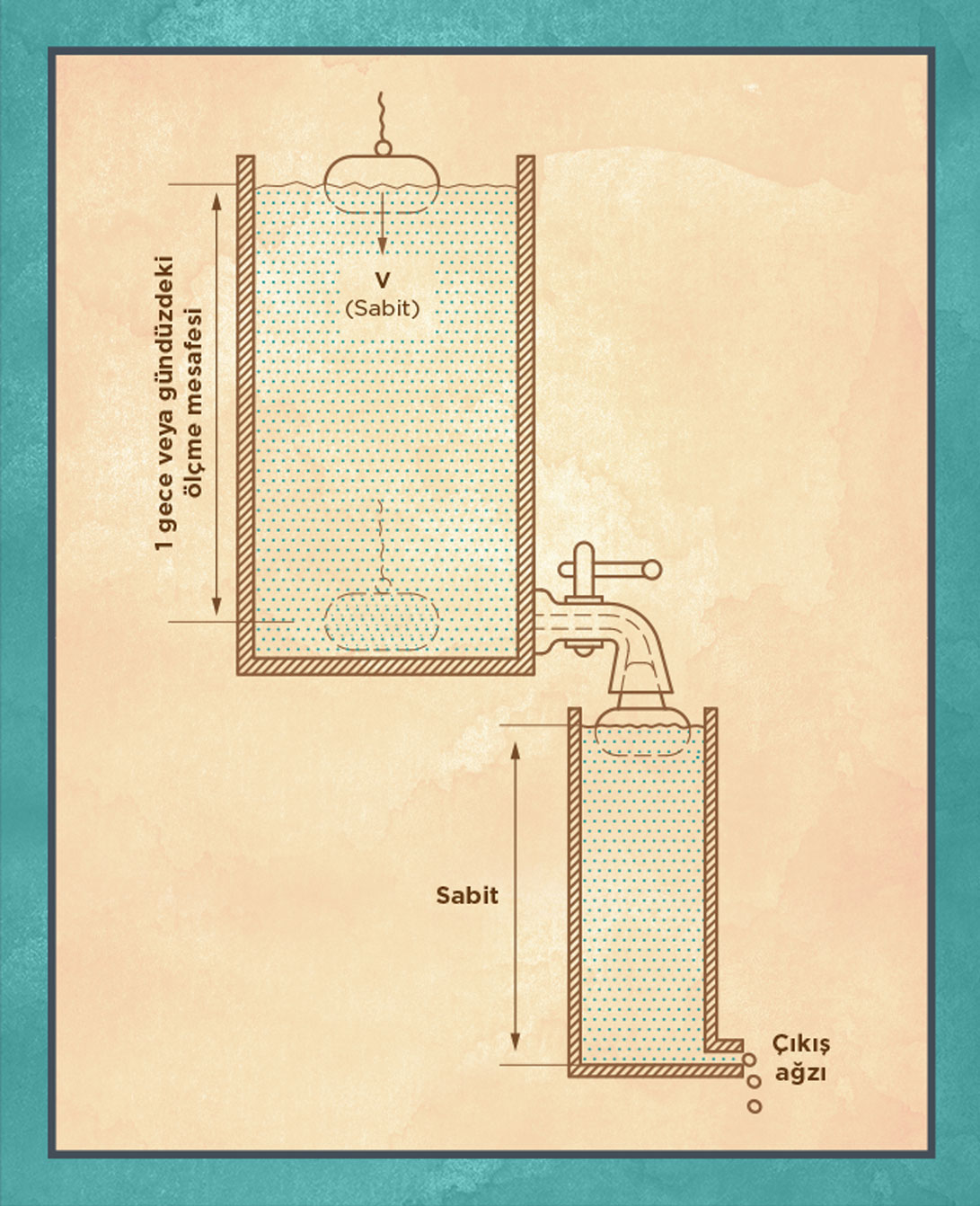
The first serious feedback system was seen in Jazari’s mechanisms. Jazari developed a unique control system to fixate the water level so that it could measure the time with equal intervals.
• The upper chamber is filled with water enough to measure the desired amount of time. And lower chamber is filled water to the trim.
• A conical stopper is placed on the surface of water in the lower chamber so that it can close the faucet under the upper chamber.
• Water level decreases as water leaks through the hole at the bottom of the lower chamber.
• In the meantime, the stopper goes down and the water flow from the upper chamber increases.
• Since the water level rises in the lower chamber, the stopper closes the faucet again.
• Due to these movements that repeat with short intervals, the water level in the lower chamber is fixed, which fixes the water flow in turn.
• Thus, the water level in the upper chamber goes down at equal intervals, and measures the time in equal units.
• Here, Jazari showed the first attempts of feedback technique, adjusting the water flow that feeds the chamber, depending on the water level in the chamber.

In this mechanism, (P) is the upper chamber that sinks the float at fixed speed. And the controller (C) is the stopper float that is made to fixate the water flow. Water level in the lower chamber determines the feedback and error value (e).
What correspondence to feedback system in human body is called bio-mechanic system. As an example to that, we can think of someone who tries to balance a stick in his hand. When we examine the bio-mechanic feedback system based on the diagram:
• The person, the arms, and the muscles can be defined as the mechanism (P).
• Person’s eye is the controller (C). It observes and controls the angular changes of the stick.
• Inner ear is the error sensor since it provides the balance.
• E is the angle and direction that the stick goes off its vertical position.
As the person tries to balance the stick in his hand, he also continuously watches the stick. When the balance is lost, with the help of his ears and arms, he rebalances himself. If we blindfold the person, we lose the controller, and we can’t keep the stick from falling.
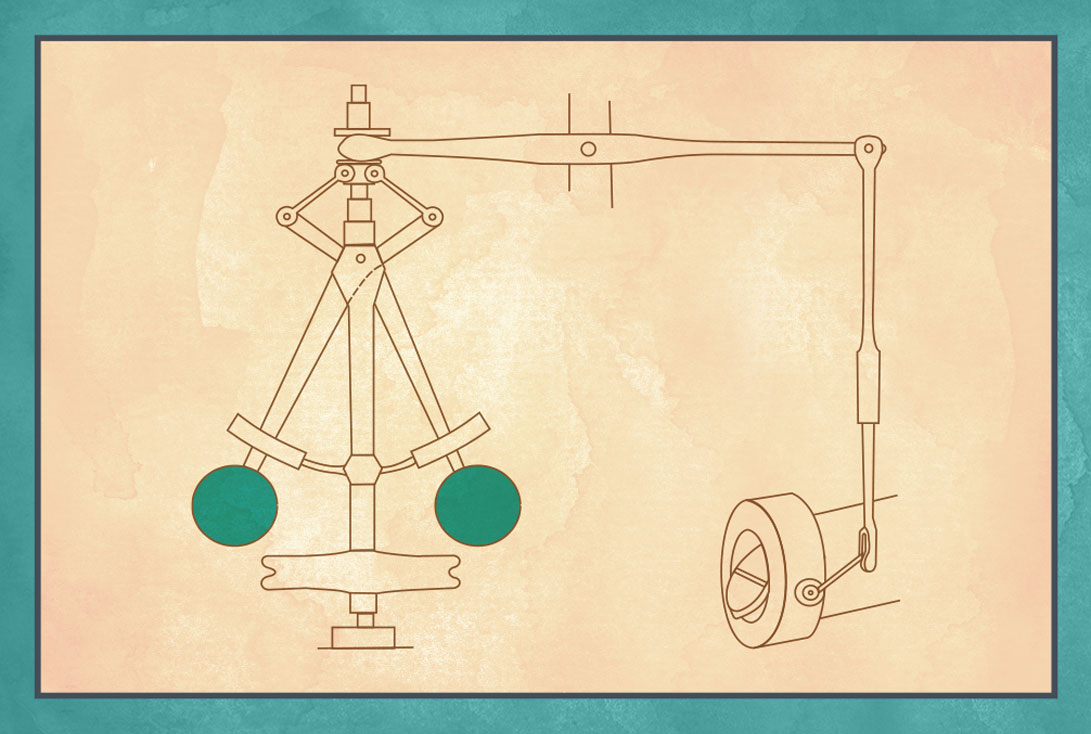
Another striking example for a feedback system was used in the steam machines in Europe hundreds of years after Jazari. The system called “Governor” works with this principle described below:
• Water that comes from the boiler goes through a valve before reaching the pistons.
• The piston, which moves back and forth with the power of steam, transforms into circular movement with the help of a crankshaft.
• To fixate this rotation at a desired speed, a shaft called Governor and the system that looks like a perpendicular gears with two balls in end are used.
• Arms open with the centrifugal force that comes from the rotation of the balls. The angle of these arms change depending on the rotation speed of the balls.
• The frontal valve that is connected to these arms open and close, based on the rotation speed.
• Thus, adjusting the steam amount, the speed can be fixated.
Monumental Water Clock Interactive Kiosk
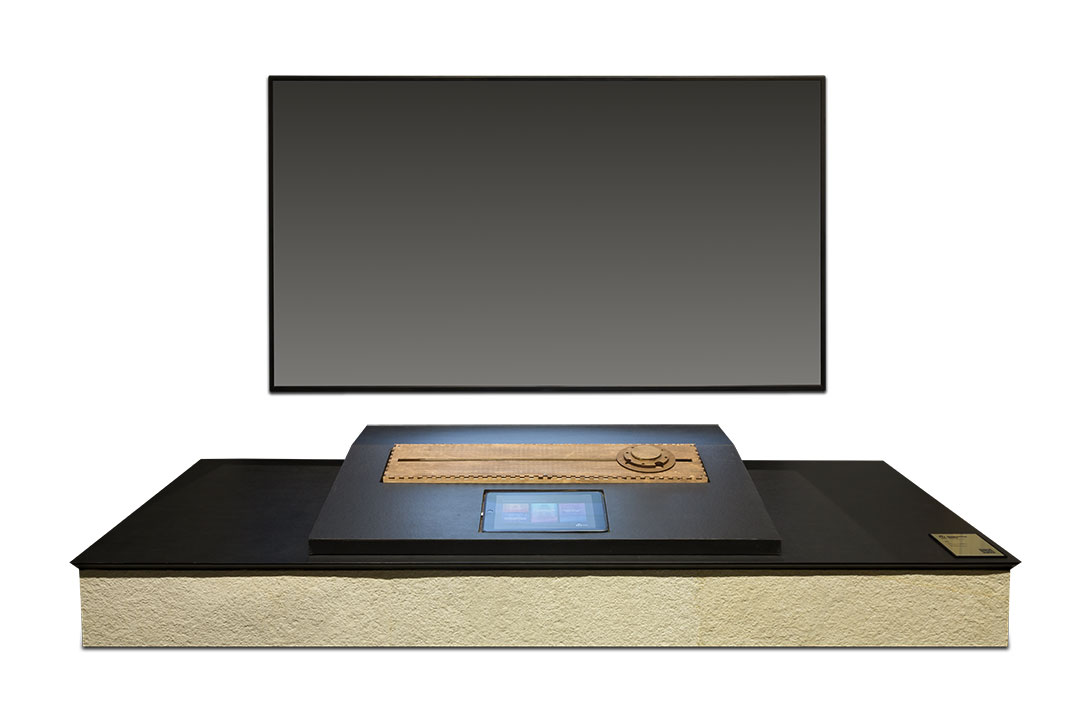
You can examine all the phases of the clock that starts running at sunrise in this kiosk mechanism that we can see the movements of the monumental clock with all its parts. You can observe how a window opens at the turn of every hour, a human figurine appearing through, and a short quote of word comes out in the windows below it. Small circular windows lined in a crescent shape at the middle lighten up, and bronze balls come out of the hawks, making a gong sound. In the meantime, the musician figurines at the bottom play drums, cymbals, and trumpets at specific times, informing people for the prayer times. You can also observe the sun’s position on the screen at that time of the day. Also, you can examine the interior mechanisms of the Monumental Water Clock in sections.
Monumental Water Clock Image

Jazari shows the Monumental Water Clock, which is his most important and the largest device he ever built, to the sultan and his guests in the ancient Artuqid palace. He points at the sun with one hand, and the synchronization between the clock and the sun with the other, explaining how it works independently.
Day and Night Spherical Projection

Our world that is called as the blue planet in our solar system provides climatic variety and amazing ecological balance with two basic movements actually. The first is its rotation around itself, and the second is its orbit around the sun.
With the rotation move, sunrays reach to the every corner of the world even if not at the same angles. Thus, while it’s daytime on the one side of the world, it’s night time on the other. Planet completes its rotation in 24 hours (1 day).
And along its orbital move around the sun, it provides the thermal balance, and the seasons are formed. This orbital move is completed in 365 days and 6 hours (1 year).
Actually, the most important element in this system is the 23.5 degree angle of its axis.
As a result of this angle, the world’s orbital move around the sun creates the seasonal changes. Different seasons are created on the northern and southern hemispheres at the same time. And again, the thermal and baric differences are formed in different seasons.
Another important effect of this angle is the continuous change in the length of the days and nights, which causes a continuous change in angles of the sunrays. If you erect a stick on the ground, you see its length changes throughout the year.
Astrolabe Corner

After 9th Century, astronomers rose from almost every corner of Islamic world, observatories were built, and countless books were penned. Al-Birunī, al-Tusī, Ibn al-Satr, Ali Kuscu, and many others became the milestones of the road that led to modern science. Systematical observations held in the observatories built in Maraga, Samarkand, and Istanbul were the institutes, using humongous devices, leading the path to the idea of modern institutes.
Observation activities weren’t only limited to the observatories, but astrolabe, rub’u’l-mukhantarāth, and water clocks were made to measure the time, to notify for the prayer times, finding the kıblah direction, and calculate the beginning of Ramadan, which all helped to solve daily needs of Islamic way of life.

